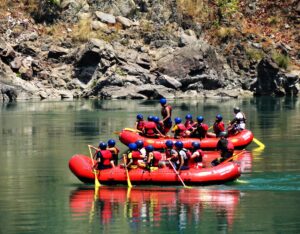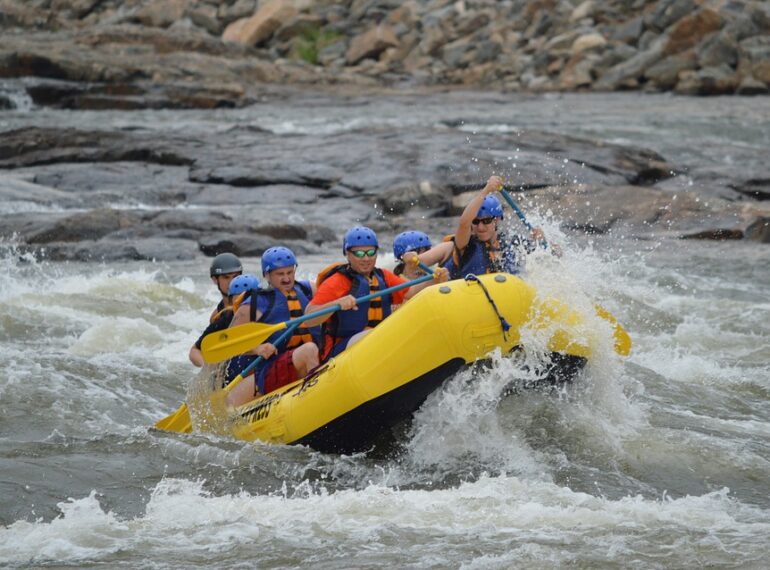
River Rafting in Kashmir
Quick Navigation
River rafting in Kashmir is an experience that combines the thrill of adventure with the beauty of nature. The roaring rapids, the pristine rivers, and the majestic landscapes create an unforgettable journey for both beginners and experienced rafters. As you navigate through the rapids, surrounded by the splendor of the Himalayas, you’ll feel the pulse of nature and discover the true essence of Kashmir. So, gear up, embrace the adventure, and let the rivers of Kashmir guide you to an experience of a lifetime.
River Rafting in Sonamarg Kashmir
Rafting in the Sindh River in Kashmir offers an exhilarating and unforgettable adventure amidst the stunning natural beauty of the region. The Sindh River, also known as the Sind River, originates from the pristine Ladakh & Sonamarg glaciers and flows through picturesque valleys, dense forests, and charming villages, making it a perfect setting for river rafting enthusiasts.
Book Srinagar to Sonamarg Taxi
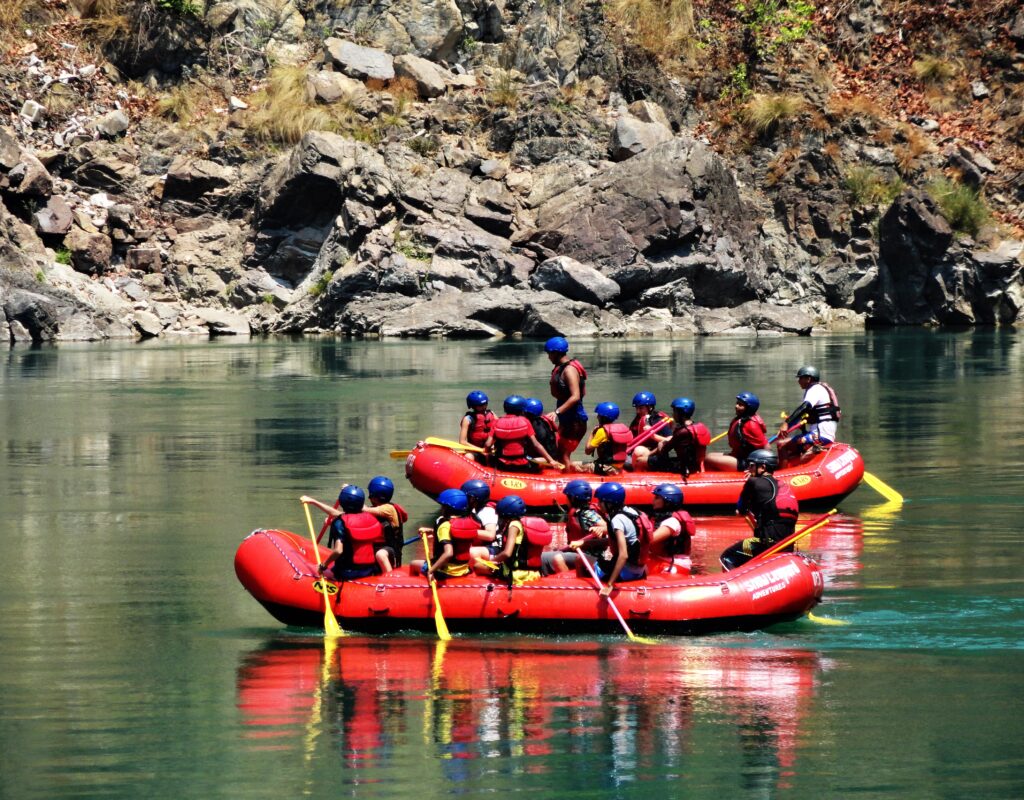
Not Actual Rafting Point
River Rafting in Pahalagam Kashmir
A Paradise for Rafting: The Lidder River, flowing through the picturesque Pahalgam region of Kashmir, is a popular destination for river rafting. With its grade II and III rapids, this river offers an exciting and thrilling experience. As you raft down the Lidder, you’ll witness the raw beauty of the Himalayan landscape, passing through quaint villages, lush meadows, and ancient temples. The journey is not just about conquering rapids but also immersing yourself in the cultural and natural heritage of Kashmir.
Book Srinagar to Pahalgam Taxi
Safety and Professional Guidance:
Safety is paramount when it comes to river rafting, and Kashmir ensures that you have a safe and enjoyable experience. The rafting operators in the region provide trained guides and high-quality equipment, ensuring your safety throughout the adventure. These experienced guides have a deep knowledge of the rivers, helping you navigate the rapids and providing assistance whenever needed. Following their instructions and guidelines will make your rafting experience both thrilling and secure.
10 WHITEWATER RAFTING SAFETY TIPS
Choose a licensed and professional rafting outfitter.
When shopping for an outfitter, ask them questions. See how long they have been in business under the current ownership. Ask them what kind of training their guides have and what government entity manages their outfitters permit and training practices. This will let you know that you are working with a professional outfitter. Picking a professional outfitter will help ensure that the following rules are followed.
Always wear a life jacket, or personal flotation device (PFD).
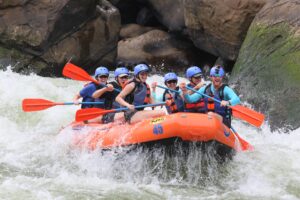
Although just because you wear a life jacket, it doesn’t mean it will save your life. It must be worn correctly. All buckles must be clipped and the jacket should be fitted snug to your body. The trick here is to have the jacket fitted so you can breathe yet the jacket should not be able to be pulled up over your head. Always have your professional guide fit your jacket. This will insure a perfect fit.
You may also read: Cloths to wear in KashmirBe safe and comfortable. Wear the protective gear.
Always wear a helmet no matter what level of rafting you are participating in. Let’s face it, you wouldn’t let your kids out to ride
 their bike or go roller blading without a helmet, why go whitewater rafting without one? It just makes good sense.
their bike or go roller blading without a helmet, why go whitewater rafting without one? It just makes good sense.Make sure you have the right outerwear for the day.
In early Spring, the water may be a little chilly. Wearing a wet suit, splash jacket, and proper river shoes can make the trip much more comfortable, allowing you to enjoy the thrill without the chill. Some outfitters rent this gear. A reputable outfitter will have gear for you. Find out before you book if the outfitter has gear for you. Raft Masters includes this gear as part of the package at no additional cost. On the other side of the spectrum: be prepared for sunny clear days. This can be accomplished by wearing quick drying clothing like polypro and wearing sunscreen and a cheap pair of sunglasses with UV protection. Raft Masters sells sun screen, sunglasses, and straps for your sunglasses so you don’t lose them. Remember sunburns can happen fast at higher elevation and can be severe. Sunburns or hypothermia are no fun.
Hold the paddle properly.
Holding the paddle properly can be a huge safety concern. One hand should be at the base of the paddle on the shaft. The other
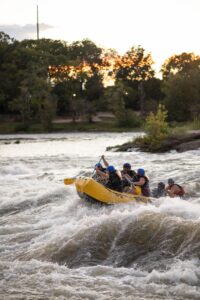 hand should ALWAYS be on the end of the shaft over the “T” grip. The “T” grip is made of hard plastic and can blacken eyes and knock out teeth. Keeping your hand over the “T” grip will keep control of the paddle and cushion the blow if it should happen. Ask your professional commercial guide for the proper technique.
hand should ALWAYS be on the end of the shaft over the “T” grip. The “T” grip is made of hard plastic and can blacken eyes and knock out teeth. Keeping your hand over the “T” grip will keep control of the paddle and cushion the blow if it should happen. Ask your professional commercial guide for the proper technique.
You may also read: Things to do in LadakhStay in the boat!
This sounds like common sense, but it can happen. One minute you are in the boat and the next you are swimming next to it. When rafting, pay attention and watch for rocks coming from downstream. Your guide may use a command called “Bump” just before the boat hits a rock. If your guide calls out, “Bump!” lean in while placing your paddle “T” grip on the floor of the boat. Make sure you still keep your hand over the grip. If the “Bump” command is executed correctly your blade end of the paddle will be up in the air and your fist over the grip will be on the floor of the boat. This should keep you in the boat. After the boat collides with the rock, return to your seat and be ready to paddle. If you fall out of the boat, the most important thing to do is… DON’T PANIC! Find your boat. Most times when someone falls out of the boat they pop up right next to the boat. Grab it so you don’t float away. If you are a couple of feet away from the boat, swim to the boat. If you pop up and you are far from the boat, look for other rescue options, other boats or the riverbank. Remember, there are two riverbanks for your convenience, one on either side of the river. If you are panicking you won’t think about getting back to the boat and the rescue becomes more difficult. Your guide will go over this in great detail during the safety talk before the trip.
Know the proper swimming techniques.
When swimming in the river, whether you fall out or you jump in for fun, there are two techniques. The first is the “Down River Swimmers Position”. This is on your back, nose and toes to the sky with your head up so you can see where you are going. Feet
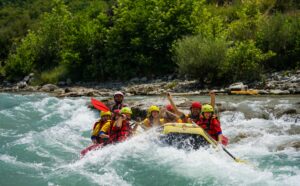 down stream with your knees slightly bent. This way if you come in contact with a rock you can use your feet and legs as shock absorbers and push off the rock. Arms should be out to your side to help keep yourself in control. A helpful hint here: keep your butt up. If you sit with your butt low in the water, you will find a rock and bring home some interesting bruises. Guys, keep your legs together. If you hit a rock we call this “romancing the stone. “ There is no romance for a couple of weeks afterwards. The second swimmers position is becoming more popular and more excepted in rescue situations. This position is on your stomach doing your best Michael Phelps impersonation. Point to where you want to go and go. Swim until you are out of the river. Again your guide will explain when it is best to use which swimming position.
down stream with your knees slightly bent. This way if you come in contact with a rock you can use your feet and legs as shock absorbers and push off the rock. Arms should be out to your side to help keep yourself in control. A helpful hint here: keep your butt up. If you sit with your butt low in the water, you will find a rock and bring home some interesting bruises. Guys, keep your legs together. If you hit a rock we call this “romancing the stone. “ There is no romance for a couple of weeks afterwards. The second swimmers position is becoming more popular and more excepted in rescue situations. This position is on your stomach doing your best Michael Phelps impersonation. Point to where you want to go and go. Swim until you are out of the river. Again your guide will explain when it is best to use which swimming position.If you choose to swim to the shore, swim all the way to the shore. NEVER stand up in moving current. Most guides never walk in water over their shins. This prevents a situation called “Foot Entrapment” which is where you put your size 9 foot in a size 8 hole or crack in the bottom of the river. This is not a good place to be but it is so easy not to get in this situation, just don’t walk in the river. It is just that easy.
You may also read: Things to do in KashmirKnow the commands – High-Siding.
When you are listing to your guide’s safety talk before the trip, pay extra attention to the part about high-siding. High-siding is a command that your guide may call out as a last ditch effort to keep the boat from capsizing. Remember: don’t panic! Chances are this won’t happen, but if it does you will have wished you paid attention during the safety talk. This situation tends to stress both guides and clients out but really it is a super easy command to execute. If the boat hits a rock or gets in a hydraulic, the boat is usually in a sideways position in the river. Water pressure will build on the upstream side of the boat, which can flip the boat over. But if your guide is Johnny on the spot and calls out, “High-side!” you need to go to the downstream part of the boat (the way the water is moving) by getting up and throwing your weight to the downstream tube of the raft. Easy peasy! Remember to always go the direction the river is flowing: downstream.
Never panic!
Panicking is a waste of time.
Listen to your guide during the safety talk and on the water.
Your experienced Raft Masters’ guide is trained to know exactly how to handle any type of situation encountered while on the river.
